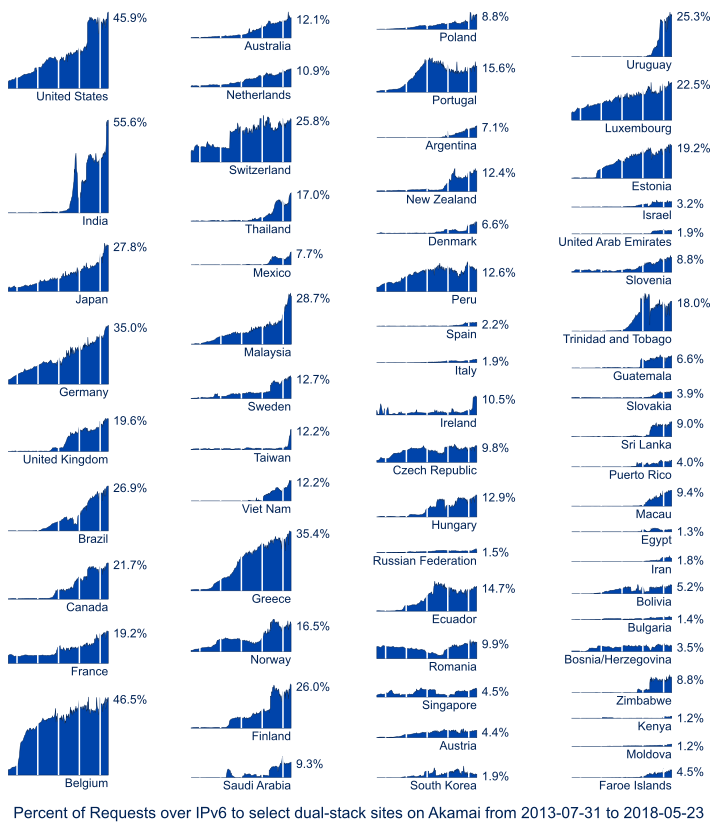Six years since World IPv6 Launch: entering the majority phases
- By nygren
- Wed 06 June 2018
See my work blog post:
Six years since World IPv6 Launch: entering the majority phases
Excerpt:
As reported in an ISOC report last year, IPv6 adoption is now solidly in the "early majority phase" of the technology adoption life cycle by many metrics (well past "innovators" and "early adopters"), with progress beyond that in some areas. Akamai continues to see solid growth in IPv6, including significant traffic peaks during large events, and we continue to find cases where IPv6 outperforms IPv4.
Driven by the growth of Internet end-users outpacing the supply of IPv4 addresses needed to number their devices, and a desire to plan for a future IPv6-based Internet, many networks around the globe are shifting to provisioning their end-users with IPv6 connectivity. Currently, IPv6 deployment in 7 of the top ten global economies has reached a point where Akamai typically sees over 18% of requests to IPv6-enabled sites using IPv6, with India (56%), U.S. (46%), Germany (35%), Japan (28%), and Brazil (27%) being well beyond this. We have come a long ways since World IPv6 Launch when we reported seeing only around 1% of U.S. end-users using IPv6. With around 80% of U.S. mobile end-users accessing IPv6-enabled Akamai sites over IPv6 (and 90% from some carriers including Reliance Jio in India), the adoption of IPv6 in the mobile space is well through the "late majority" phase.
Over the past year IPv6 has been enabled on many of the largest online streaming events on the Internet, as delivered by Akamai, such as numerous major sporting events including the VIVO IPL and some major broadcasters of the Olympics. During these we've often seen between roughly a quarter (¼) and two-thirds (⅔) of the global event traffic delivered over IPv6, depending on the audience distribution. We often see a considerably higher average throughput to IPv6 end-users than to IPv4 end-users during dual-stacked events (although some of this may be due to sample bias). We've even seen multiple recent cases where massive IPv4-only events caused problems for CGNAT middle-boxes but IPv6 traffic continued to flow unimpeded.
For dual-stacked hostnames we typically see higher average estimated throughput over IPv6 than over IPv4. Some of this may be due to IPv6-connected users being correlated with better connectivity, but over half of dual-stacked hostnames (weighted by daily bytes delivered) have IPv6 estimated throughput at least 50% faster than IPv4, and 90% of these hostnames have the IPv6 estimated throughput at least 10% faster than IPv4. Individual sites and network providers will vary (with IPv6 performing worse than IPv4 in some cases). However the overall trend aligns with past results from LinkedIn, Facebook, Akamai, and others that show IPv6 as delivering significantly better performance than IPv4, especially in some mobile networks. As reported in an ISOC report last year, IPv6 adoption is now solidly in the "early majority phase" of the technology adoption life cycle by many metrics (well past "innovators" and "early adopters"), with progress beyond that in some areas. Akamai continues to see solid growth in IPv6, including significant traffic peaks during large events, and we continue to find cases where IPv6 outperforms IPv4.
Driven by the growth of Internet end-users outpacing the supply of IPv4 addresses needed to number their devices, and a desire to plan for a future IPv6-based Internet, many networks around the globe are shifting to provisioning their end-users with IPv6 connectivity. Currently, IPv6 deployment in 7 of the top ten global economies has reached a point where Akamai typically sees over 18% of requests to IPv6-enabled sites using IPv6, with India (56%), U.S. (46%), Germany (35%), Japan (28%), and Brazil (27%) being well beyond this. We have come a long ways since World IPv6 Launch when we reported seeing only around 1% of U.S. end-users using IPv6. With around 80% of U.S. mobile end-users accessing IPv6-enabled Akamai sites over IPv6 (and 90% from some carriers including Reliance Jio in India), the adoption of IPv6 in the mobile space is well through the "late majority" phase.
Over the past year IPv6 has been enabled on many of the largest online streaming events on the Internet, as delivered by Akamai, such as numerous major sporting events including the VIVO IPL and some major broadcasters of the Olympics. During these we've often seen between roughly a quarter (¼) and two-thirds (⅔) of the global event traffic delivered over IPv6, depending on the audience distribution. We often see a considerably higher average throughput to IPv6 end-users than to IPv4 end-users during dual-stacked events (although some of this may be due to sample bias). We've even seen multiple recent cases where massive IPv4-only events caused problems for CGNAT middle-boxes but IPv6 traffic continued to flow unimpeded.
For dual-stacked hostnames we typically see higher average estimated throughput over IPv6 than over IPv4. Some of this may be due to IPv6-connected users being correlated with better connectivity, but over half of dual-stacked hostnames (weighted by daily bytes delivered) have IPv6 estimated throughput at least 50% faster than IPv4, and 90% of these hostnames have the IPv6 estimated throughput at least 10% faster than IPv4. Individual sites and network providers will vary (with IPv6 performing worse than IPv4 in some cases). However the overall trend aligns with past results from LinkedIn, Facebook, Akamai, and others that show IPv6 as delivering significantly better performance than IPv4, especially in some mobile networks.
